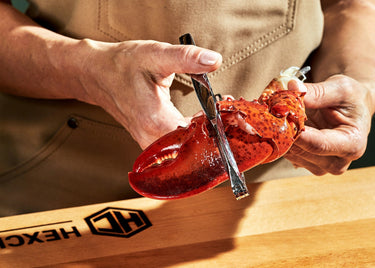4 Reasons Not to Fear Cooking Lobster

Imagine sitting by a rocky shoreline, the sun streaming through puffy clouds, with the salty smell of summer air wafting by. In your hand there’s a red-and-white checked paper container cradling a perfectly soft hot-dog bun topped with chunks of tender, mayonnaise-dressed lobster, and a sprinkling of chives. Is there anything better? Wouldn’t you like to bring those Maine vibes home with you? Yes! (And September is still prime lobster-eating time.)
But wait…doesn’t that require…cooking a lobster alive?!
Before you "hard pass" on the idea, hear us out: cooking lobster is not that scary. Read on for our helpful advice, courtesy of HexClad Food Director Laura Rege, who shared some helpful tips for conquering this tasty sea creature.
“There’s no need to freak out,” said Rege, who developed HexClad’s Maine-Style Lobster Roll. “There’s nothing that different between cooking a lobster and boiling pasta.” Seriously.
Cut to you cranking out Maine-Style Lobster Rolls, lobster pasta, lobster bisque, and even lobster eggs Benedict. The ocean's the limit.
4 REASONS NOT TO FEAR COOKING LOBSTER

1. SKIP THE SCARY KNIFE TRICK; TAKE THE PLUNGE INSTEAD
In our cushy, modern-day kitchens, we’re not used to killing food ourselves before beginning to cook. But, with homemade lobster, that’s a necessary step standing between you and that hot, buttered bun. You might have read that plunging a knife into the lobster’s head and dragging it downwards is the most humane method, BUT that can be a bit much for squeamish cooks. Instead, opt for boiling water. And, as Rege said, once the lobster hits the boiling water, it’s going to cook quickly, so don’t worry too much about the lobster suffering.
2. USE YOUR BIGGEST POT
The key to lobster meat that’s tender, not rubbery, is making sure the water stays at a boil once you add the lobster. To do that, you’ll want to use your largest pot, said Rege. “It’s a question of the right tool for the task.”
What do we mean by a big enough pot to cook lobster? Ideally, your 12QT Hybrid Stock Pot (or your 10QT Hybrid Stock Pot in a pinch) would work best. Fill it three-quarters full (that’s about 9 quarts total). Cover it, bring it to a boil, season generously with salt (a quarter cup should do), and then bring it back to a full boil before adding two lobsters at a time. Any more and the water temperature will decrease too much, Rege said. Our recipe calls for just two lobsters, but if you want to make a bigger batch, Rege recommends waiting for the water to come back to a boil before proceeding with more lobsters.

3. LEAVE THE RUBBER BANDS ON
While some recipes will tell you to take the rubber bands off the claws, Rege suggests keeping them on until after you’ve cooked the lobsters. This is for a fairly practical reason that definitely turns the volume down on the fear quotient: The lobsters are less likely to snap at you as you quickly transfer them to the pot.
4. A TEMPERATURE CHART CAN MAKE THINGS MUCH EASIER
There are some things that require a certain je ne sais quoi in the kitchen, but lobster isn’t one of them since the signature red color will arrive long before the meat is ready to eat. Rege suggests looking up a cooking chart if your lobsters don’t perfectly match the recipe’s suggested 1½ pounds.

Once you’ve cooked your lobsters, you’re one step closer to dreamy New England–style lobster rolls. Just twist off the tails, claws and legs, then get cracking on the shells. Rege recommends using a mallet to crack them before discarding the shells (or keeping them for a lobster stock). Making the lobster salad is easy: Chop the meat, toss it with finely diced celery, mayonnaise, lemon juice and an optional pinch of cayenne pepper.
Still a bit nervous? Think of getting comfortable with cooking lobster as a level up as a cook, psychologically at least. Remember, said Rege, if you can boil pasta, then you can cook a lobster.





